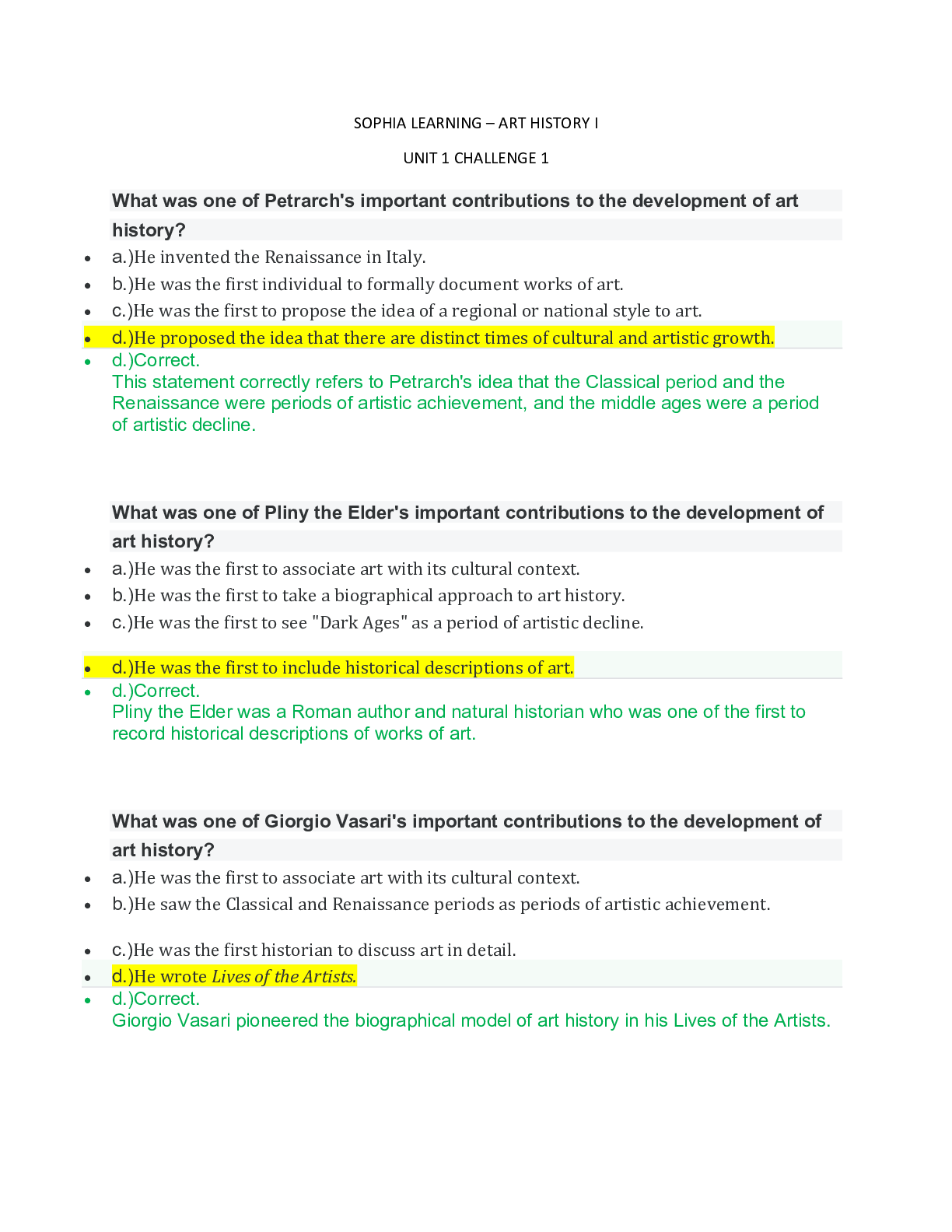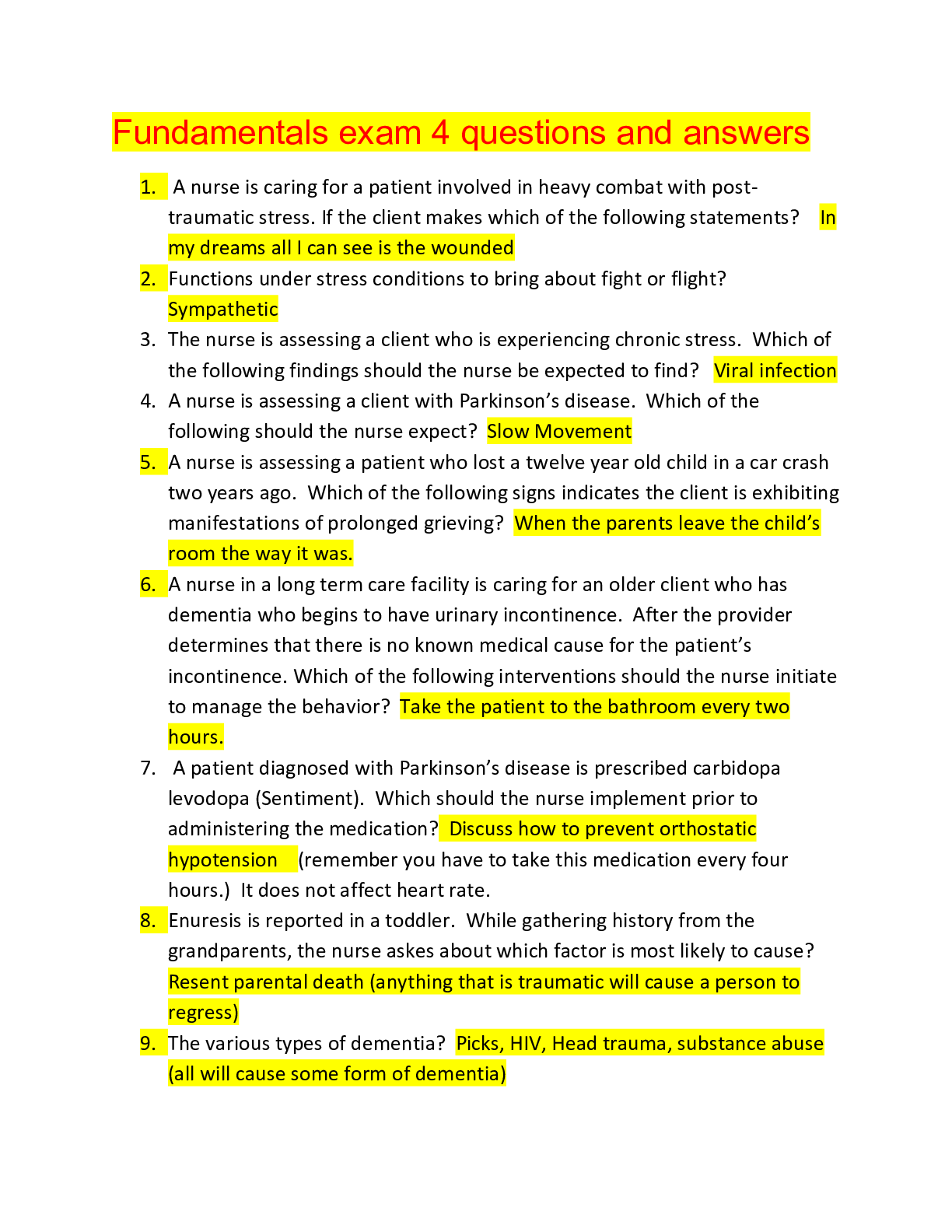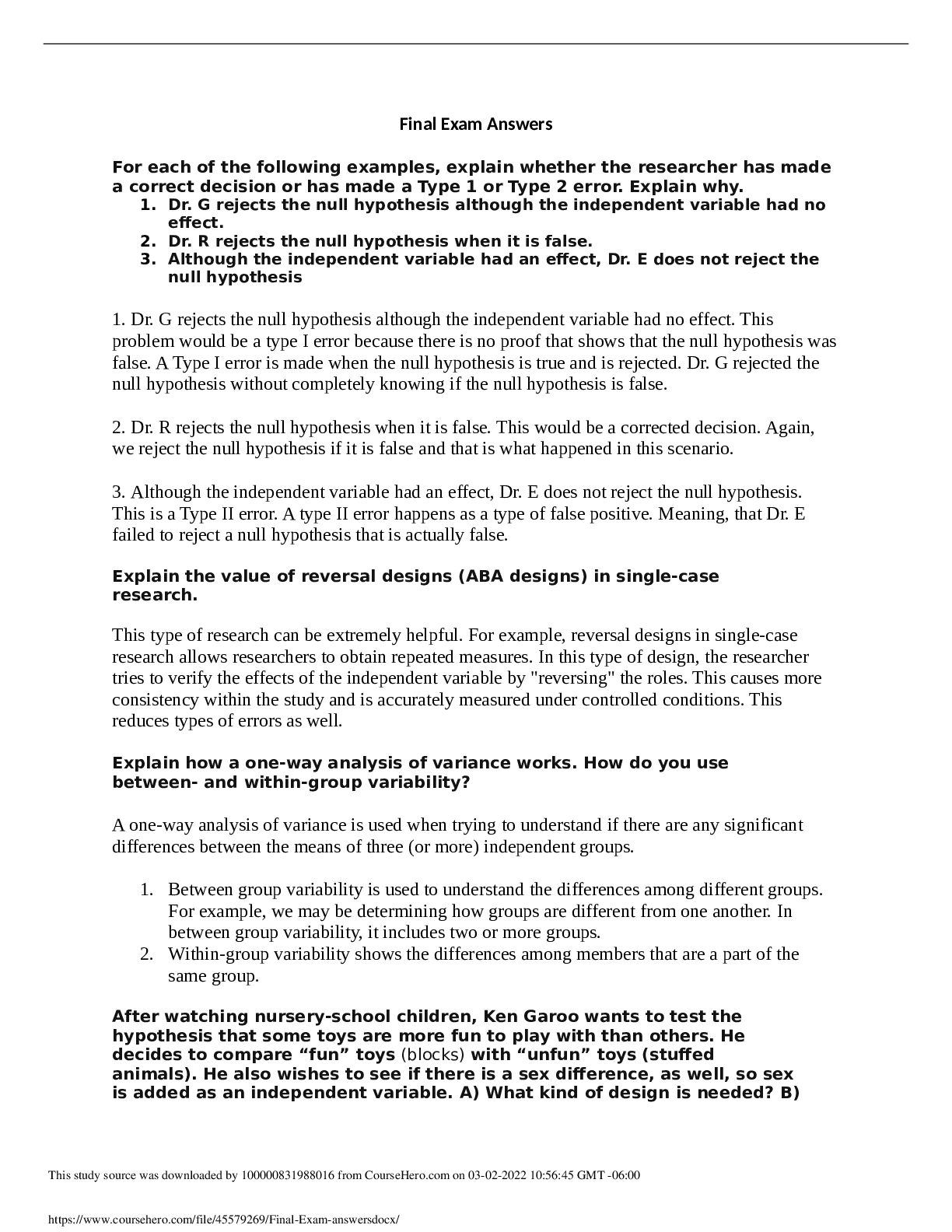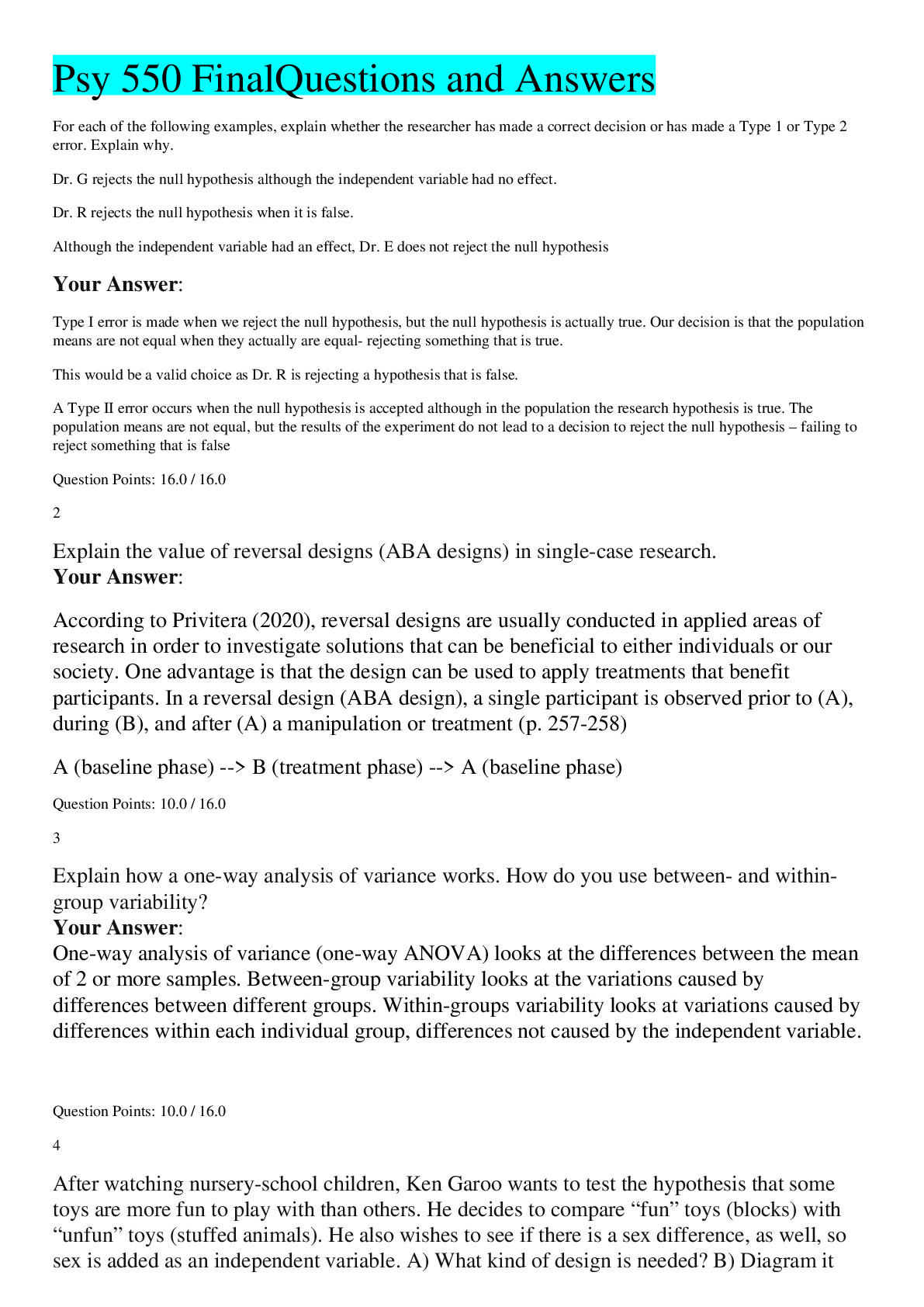English Language > EXAM > CALT Exam Study Guide Quiz Questions and Answers,100% CORRECT (All)
CALT Exam Study Guide Quiz Questions and Answers,100% CORRECT
Document Content and Description Below
CALT Exam Study Guide Quiz Questions and Answers Rhyming - Correct Answers One of the first phonological awareness skills to develop Blending & segmenting at syllable level - Correct Answers Dev... elops at 3-4 years Segmenting phonemes - Correct Answers Develops at 4-5 years Isolating beginning sound in words, segmenting phonemes in CVC words - Correct Answers Develops in kindergarten Segmenting words with consonant blends - Correct Answers Develops in first grade Receptive oral language - Correct Answers Listening Expressive oral language - Correct Answers Speaking Receptive written language - Correct Answers Reading Expressive written language - Correct Answers Writing __ letters representing __ phonemes - Correct Answers26, 44 5 vowel letters, __ vowel sounds - Correct Answers15 Long vowels - Correct AnswersTense Vowels. (Beet, bait, boat, boot, bite, boy, bout) (a, e, i, o, u, oy, ou, oo) Short vowels - Correct Answers Lax vowels - pat, pet, pit, pot, put, putt (a, e, i ,o, u, oo) Fricatives - Correct Answers produced by a constant flow of air through the vocal tract (f and v) Affricates - Correct Answers ch/j Glides - Correct Answers W, y Liquids - Correct Answer sl, r Alphabetic principle - Correct Answers an understanding that letters and letter patterns represent the sounds of spoken language Six syllable types - Correct Answer sclosed, open, VCe, C+le, R controlled, vowel pairs Semantics - Correct Answers Language content— meaning of words and the relationship between and among words Pragmatics - Correct Answers Language use— reasons, codes/styles, conversation rules Phonology - Correct Answers the study of speech sounds in language Morphology - Correct Answers units of meaning involved in word formation Syntax - Correct Answers the rules for combining words into grammatically sensible sentences in a given language Teutonic Invasion - Correct Answers Shifted the balance of power in Central Europe leading up to the Christianizing of Britain Norman Conquest - Correct Answers Began in 1066. Led by William the Conquerer . His military victory at the Battle of Hastings led to Norman control of England. This control would influence England more with continental Europe than Scandinavian culture. Would also lead to rivalry between England and France for the next millenium. Renaissance - Correct Answers"rebirth"; following the Middle Ages, a movement that centered on the revival of interest in the classical learning of Greece and Rome The Great Vowel Shift - Correct Answersa phonetic shift in the way that long vowels were pronounced in English Dyslexia - Correct Answers A specific learning disability that is neurological in origin. It is a deficit in the phonological component of language and is characterized by poor spelling and decoding abilities. Inferior frontal gyrus - Correct Answers Broca's area — articulation and word analysis Parieto-temporal area - Correct Answers Brain part responsible for word analysis Occipito-temporal region - Correct Answers The vision center — word form Angular gyrus - Correct Answers transforms visual representations into an auditory code Wernicke's area - Correct Answers controls language reception - a brain area involved in language comprehension and expression; in the parieto-temporal lobe Decode - Correct Answers Determine pronunciation of a word by breaking it down into sounds Encode - Correct Answers To spell Child pretends to read, can name letters of alphabet (6 mos-6 yrs) - Correct Answers Jean Chills’ stages of reading development, Stage 0-pre-reading Child learns relation btwn letters and sounds, printed and spoken words; can read simple text (grades 1-2.5) - Correct Answers Jean Chall's Stages of Reading Development, stage 1-initial reading and decoding Child reads simple stories with increasing fluency (grades 2.5-3) - Correct Answers Jean Chall's Stages of Reading Development, stage 2-confirmation and fluency Reading is a tool for acquiring new knowledge (grades 4-8) - Correct Answers Jean Chall's stage 3 - Reading for New Learning Child reads critically from a broad range of complex materials (high school) - Correct AnswersJean Chall's stage 4- Reading from Multiple Viewpoints Reading is used for one's own needs and purposes and is rapid and efficient (college and beyond) - Correct Answers Jean Chall's stage 5- Construction and Reconstruction Prephonetic Stage of spelling development - Correct Answers Not all sounds of the words are represented by letters (example: js for dress) Semiphonetic Stage of Spelling Development - Correct Answers Child strings together consonants to represent speech sounds (example: ntr for enter) phonetic stage of spelling development - Correct Answers Every sound is represented but lacking the complete knowledge of conventional orthography (example: sede for seed) Writing Stage 1 - Correct Answers Imitation (preschool-first grade)— pretending to write, can organize letters and shapes in a line Writing Stage 3 - Correct Answers Progressive Incorporation (late second to fourth grade)—students gradually incorporate standards of mechanics; little advanced planning Writing Stage 2 - Correct Answers Graphic presentation (first and second grade)—Students are adept at printing letters, preoccupied with appearance of letters, likely to make reversals, invented spellers Writing Stage 4 - Correct Answers Automatization (fourth-seventh grade)— students apply rules of mechanics automatically, sentences become more sophisticated, begin to assess their own writing Writing Stage 5 - Correct Answers Elaboration (seventh-ninth grade)—writing to express a viewpoint, synthesizing, writing level exceeds their own speech Writing Stage 6 - Correct Answers Personalization-Diversification (ninth grade and beyond)—use of different writing styles, creative, complex, sophisticated vocabulary Phonological processing - Correct Answers Umbrella term for broad category of oral language processing abilities related to sounds in words and associated with the ability to read well Phonological memory - Correct Answersability to remember speech sounds briefly Phonological awareness - Correct Answersthe ability to reflect on and manipulate the sound segments in words; phonemic awareness is one component Naming speed - Correct AnswersThe rate at which a child can recite "overlearned" stimuli such as letters and single-digit numbers. Dysarthria - Correct Answers the inability to use speech that is distinct and connected because of a loss of muscle control after damage to the peripheral or central nervous system Dyspraxia - Correct Answers Sensorimotor disruption in which the motor signals to the muscles, such as those necessary for speech production, are not consistently or efficiently received (a person is born with dyspraxia) Apraxia - Correct AnswersA disorder that prevents certain complex muscular movements, caused by damage to the brain Echolalia - Correct Answers The uncontrollable and immediate repetition of words spoken by another person Dysphasia - Correct Answers Difficulty in learning both listening and speaking skills despite adequate hearing, intelligence, and opportunity otitis media - Correct Answers inflammation of the middle ear that can lead to hearing loss Alexia - Correct Answer sthe loss of the ability to read, usually the result of brain injury Alveolar - Correct AnswersArticulation made with the ridge behind the teeth Palatal - Correct AnswersArticulation made with the roof of the mouth Velar - Correct AnswersArticulation made at the back of the mouth Glottal - Correct AnswersArticulation made from the throat Major syllable division patterns - Correct AnswersVCCV, VCV, VCCCV, VV Root - Correct AnswersA word part that carries meaning and provides the base for an affix Stem - Correct AnswersA bound morpheme/word part that must have an affix Base word - Correct AnswersThe simplest form of an English word Morpheme - Correct AnswersThe smallest meaningful linguistic unit Free morpheme - Correct AnswersUnbound word part, can stand alone as a word Inflectional endings - Correct Answerssuffixes that express plurality or possession when added to a noun (e.g. girls, girl's), tense when added to a verb (e.g. walked, walking), or comparison when added to an adjective (e.g. happier, happiest). Derivational endings - Correct AnswersEndings that change the meaning and part of speech of a word. Example: er, ism, its, ful, able, ation, ness, ment, ify, ly (teach, teacher) Old English - Correct AnswersThe Anglo-Saxon language spoken from approximately 450 to 1066 A.D. in what is now Great Britain. Middle English - Correct AnswersThe language spoken in England roughly between 1066 and 1500 A.D. Word blindness - Correct Answers1877- Kussmaul used this early term for people who couldn't read despite having normal vision; then Samuel T. Orton coined the term in the 1920s. Professor Berlin - Correct AnswersA Stuttgart professor who first used the term dyslexia in 1887 Congenital word blindness - Correct AnswersDr. W. Pringle Morgan and Dr. James Hinshelwood used this term to describe an inability to learn to read despite no injury or illness — 1896 strephosymbolia - Correct Answersterm meaning "twisted symbols" coined by Dr. Samuel T. Orton to describe specific dyslexia Specific language disability - Correct AnswersAnna Gillingham used this term in 1955 and June Orton used it in 1962 Samuel T. Orton - Correct AnswersFather of Dyslexia, used the term strephosymbolia, determined that dyslexia was not a visual problem but a language problem Simple View of Reading - Correct AnswersPhilip Gough's idea that reading is comprised of two components: decoding and listening comprehension 85% - Correct AnswersThe percentage of LD students who have a primary learning disability in reading and language processing 15-20% - Correct AnswersPercentage of people who have symptoms of dyslexia Norm-referenced tests - Correct Answersstandardized tests that compare an individual child's score to the average score of others her age (Woodcock-Johnson) Criterion-referenced tests - Correct AnswersTests where the student's performance is compared to a standard or criterion. The student's score is not based on how he/she compared with other students, but rather on how the student did as measured by the criteria or standards. (Dibels, TPRI, STAAR, SAT) What should be included in a dyslexia evaluation - Correct AnswersBackground/family information, intelligence, reading words in isolation/decoding, phonological awareness, letter knowledge, rapid naming, fluency/rate and accuracy, reading and listening comprehension, spelling Orton-Gillingham approach - Correct AnswersThe structured, sequential, multisensory techniques established by Dr. Orton and Ms. Gillingham and colleagues in the 1930s Isabelle Liberman - Correct AnswersPresented evidence that most cases of reading disability result from deficits in phonological processing and weaknesses with the language system in the brain. Keith Stanovich - Correct AnswersHis research in the field of reading was fundamental to the emergence of today's scientific consensus about what reading is, how it works and what it does for the mind. The Matthew Effect Maryanne Wolf and Patricia Bowers - Correct AnswersCoined the term "double deficit" to describe students who had difficulty with both phonological processing and rapid naming (1986) Reid Lyon - Correct AnswersNeuropsychologist in charge of NIH reading research. Confirmed importance of phonological awareness. He's at Southern Methodist U in Dallas. Section 504 - Correct AnswersFalls under the Rehabilitation Act of 1973 and prohibits discrimination and ensures FAPE IDEA law - Correct AnswersIndividuals with Disabilities Education Act, a federal Sped law that ensures FAPE in the least restrictive environment Fernald - Correct Answers Developed a kinesthetic system for teaching the deaf; Orton was influenced by her work Sibilant sounds - Correct AnswersSubset of fricative sounds, using hissing sounds (s) (ks) (z) (ch) (sh) (zh) Was first to advocate for multisensory instruction for "congenital word blindness" - Correct AnswersJames Hinshelwood Anna Gillingham and Bessie Stillman - Correct AnswersDeveloped a phonics approach following Orrin's theories using V-A-K instruction Luke Waites - Correct AnswersA pioneer in the treatment of dyslexia Aylett Cox - Correct AnswersDeveloped Alphabetic Phonics curriculum with Dr. Waites and the staff at Scottish Rite. She built off of Gillingham, adding key words and discovery learning. 1968 - Correct AnswersWorld Federation of Neurology approves dyslexia definition [Show More]
Last updated: 1 year ago
Preview 1 out of 9 pages
Instant download
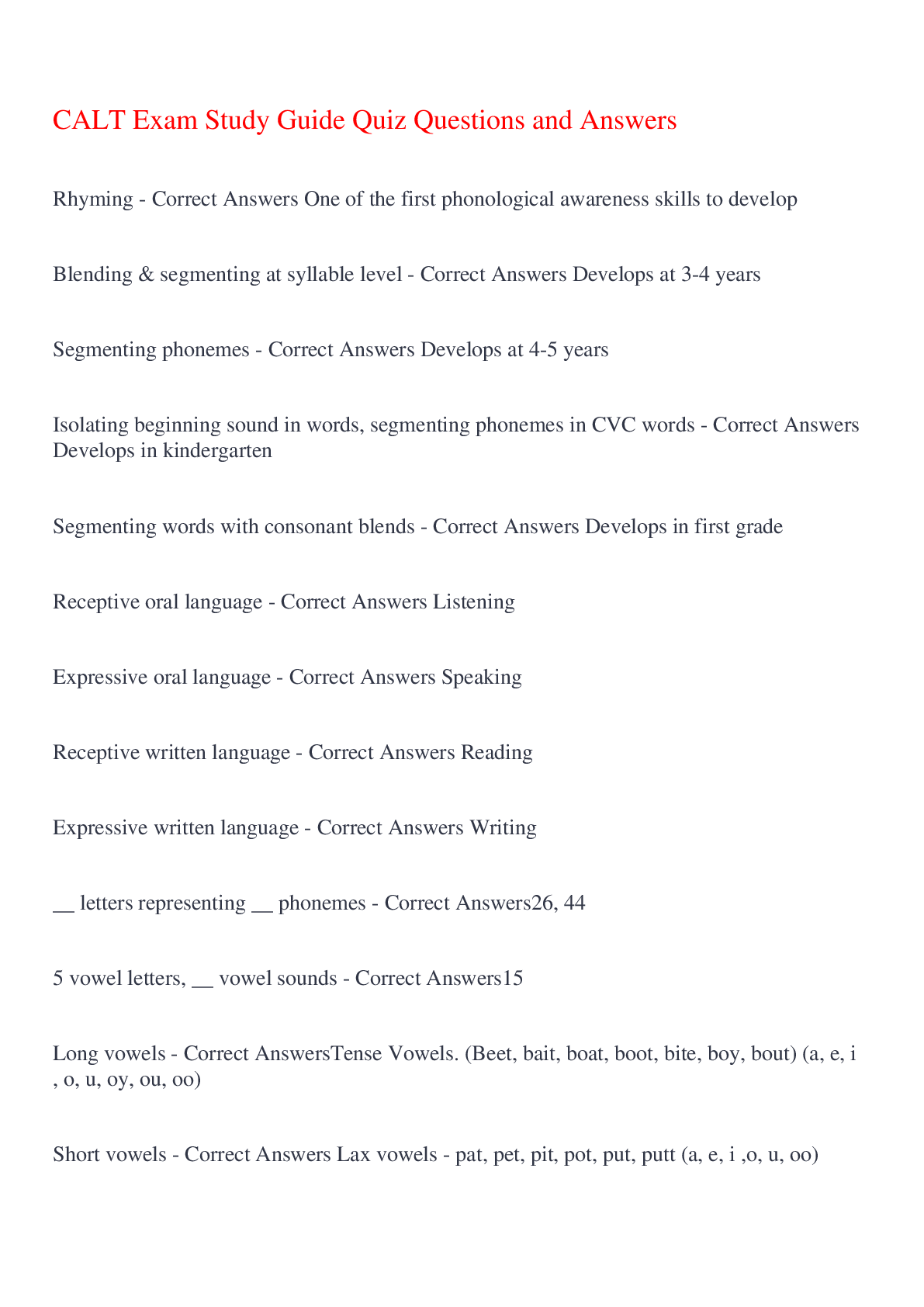
Buy this document to get the full access instantly
Instant Download Access after purchase
Add to cartInstant download
Reviews( 0 )
Document information
Connected school, study & course
About the document
Uploaded On
Feb 10, 2023
Number of pages
9
Written in
Additional information
This document has been written for:
Uploaded
Feb 10, 2023
Downloads
0
Views
59














